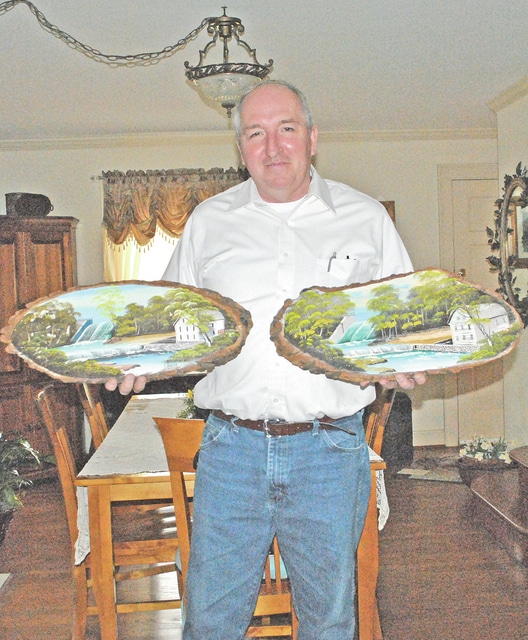
Because he treasures most all things pertaining to Rocky Fork Lake, Ben Sexton could not refuse when he was recently asked to give a presentation on the lake’s history – even though the idea was his in the first place.
“We were in a meeting barnstorming and I had an idea that wouldn’t it be neat if we got somebody in here to talk about the history of Rocky Fork Lake. The search for that person came up empty-handed, so I was honored to be volunteered to have the job,” Sexton joked Tuesday.
So, he set about gathering memorabilia and information and last Thursday gave an interesting presentation with lots of pictures and illustrations about the lake to a large crowd gathered for a Rocky Fork Community Alliance (RFCA) meeting.
This spring will mark the 64th anniversary since water first spilled over the Rocky Fork dam in April of 1953.
Colonel Walter H. Hutchins was a Cincinnati resident a regular visitor to Highland County. “He and other visitors were drawn to this area by the beauty of the Rocky Fork gorge and The Seven Caves as early as the mid 1800s,” Sexton, the vice president of the RFCA, told the crowd. “Colonel Hutchins was the one who first had the dream of constructing a dam near McCoppin’s Mill and was also the lake’s biggest promoter.”
Planning for the lake began in the late 1940s by what was then known as the Division of Conservation and Natural Resources. Clearing of timber in the lake area began in 1949, and construction of the dam started in 1951.
According to Sexton, a total of 30,000 cubic yards of concrete were to used to build the dam, the height of the observation platform to the bottom level of the dam is approximately 70 feet, and the width of the spillway is 154 feet.
Construction of the North Beach area was still underway even after the lake filled with water. Boats were first allowed on the lake in 1953, and one of the original boat ramps was located at the end of a road that is now a circle drive alongside North Beach. The boat ramps at North Beach and Blinco were not constructed until 1954.
Before the lake was built, Sexton said, Blue Ribbon Road ran from SR 124 to U.S. Route 50 and there was a covered bridge where the road crossed over Rocky Fork Creek.
In the meantime, Rocky Fork became a state park in 1950 with a total of 3,484 acres, including 2,080 acres devoted to the lake itself. Unlike Paint Creek Lake, which was built to control flooding, Sexton said his understanding is that Rocky Fork was constructed strictly for recreational purposes and economic development.
No history of the lake, Sexton said, would be complete without discussing Barrett’s Mill. The mill itself was destroyed by fire several years ago, but the dam that powered it still exits and is located just below the Rocky Fork dam.
The mill was established in 1829 and was in operation as an actual mill until Feb. 9, 1979 when it was owned by Lynn A. Sidenstricker. He purchased the mill in 1952 from Harry McCoppin after working for McCoppin for several years.
The mill was used strictly to grind wheat flour and consisted of four roll stands powered by two water turbines. It was capable milling seven tons of flour a week and one of the biggest challenges was transporting the flour to the city.
“Some of the flour was sold to The Martha White Company in Huntington, W.Va.,” Sexton said. “The mill did offer milling services for grains other than wheat to local farmers by use of a gasoline-powered grinder. There were some water-related issues during the contraction of the lake and state agreed to a settlement for the purchase of a gasoline engine for the mill. Unfortunately, during the construction of the dam there was a young man who died at the site. Jerry McCoy was unaware of the dredging that had been done and drowned while swimming.”
In the late 1800s, the mill was owned by Thomas Costello. He promoted the Black Diamond Railroad Company’s proposal to bring a rail line through the area. Sexton said the line would have brought a depot, stockyard and telegraph office to Rainsboro. And, a town that was to be named “Lodore” was to built near the mill. A post office was erected at the mill at that time, but it closed in 1903 because the railroad never made it past the planning stages. Costello died in a milling accident in 1906.
Sexton, who two years ago started a camping business at the lake called Old Days Vintage Campers, said he remembers the days when there were exciting and successful businesses at the lake like Wanta-Linga, Fun-n-Sun and the Francis Marina. He said he and others are interested in restoring the lake to its former glory.
There have been recent indications that recovery for the area is underway.
The Rocky Fork Lake Area Safety and Advancement Project was recently awarded a grant of more than $800,000 from the U.S. Department of Justice to initiate a plan to improve economic development and fight crime at the lake. And Highland County Sheriff Donnie Barrera is in the process of opening a new sheriff’s office substation at the lake.
“Whether you’ve come here tonight to learn history, view old photographs or relive fond memories of days past, we at the Rocky Fork Community Alliance appreciate your presence at this meeting,” Sexton told last week’s crowd. “Rocky Fork Lake, now more than ever, has the potential to become so much more than what we’re used to. Be part of it. Get involved. Join us at the Rocky Fork Community Alliance.”
The RFCA meets at 7 p.m. the third Thursday of each month at the Rocky Fork Activity Center.
Reach Jeff Gilliland at 937-402-2522 or on Twitter @13gillilandj.


